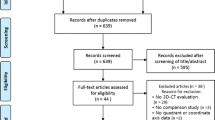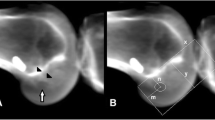Abstract
Purpose
The position of the osseous tunnels and graft during anterior cruciate ligament (ACL) reconstruction has been the subject of multiple studies aiming for either anatomical placement or an alternative. The assessment of these positions, using post-operative imaging, is therefore of interest to the surgeon in both the evaluation of surgical performance and surveillance of potential complications. The purpose of this review is to identify the optimal use of imaging in both the surveillance of clinical practice and in planning revision surgery.
Methods
A comprehensive systematic review was performed using Medline and Pubmed searches to identify radiological methods used to assess ACL reconstruction tunnel position. Commonly used methods were identified with correlation to either native anatomy or clinical results.
Results
The findings suggest that plain radiographs can be used to assess tunnel position and identify grafts that are positioned non-anatomically and may be at increased risk of complications. Computer tomography (CT) offers additional information about the tunnel aperture shape and size that is of importance for revision surgery and research projects whilst magnetic resonance imaging (MRI) provides further assessment of both graft integrity and associated soft tissue damage.
Conclusion
In the surveillance of routine clinical practice, plain radiographs are sufficient to define tunnel position. The additional information provided by three-dimensional imaging is only required in revision surgery or research studies.
Level of evidence
IV.









Similar content being viewed by others
Abbreviations
- ACL:
-
Anterior cruciate ligament
- ACLR:
-
Anterior cruciate ligament reconstruction
- AM:
-
Anteromedial
- AP:
-
Anteroposterior
- CT:
-
Computer tomography
- FTA:
-
Femoral tunnel angle
- ICC:
-
Intraclass correlation coefficient
- IKDC:
-
International Knee Documentation Committee
- MRI:
-
Magnetic resonance imaging
- PCC:
-
Pearson’s Correlation Coefficient
- THL:
-
Tibial horizontal line
- 3D-CT:
-
Three-dimensional computer tomography
References
Aglietti P, Buzzi R, Giron F, Simeone AJ, Zaccherotti G (1997) Arthroscopic-assisted anterior cruciate ligament reconstruction with the central third patellar tendon. A 5-8-year follow-up. Knee Surg Sports Traumatol Arthrosc 5:138–144
Amis AA, Beynnon B, Blankevoort L, Chambat P, Christel P, Durselen L, Friederich N, Grood E, Hertel P, Jakob R et al (1994) Proceedings of the ESSKA scientific workshop on reconstruction of the anterior and posterior cruciate ligaments. Knee Surg Sports Traumatol Arthrosc 2:124–132
Amis AA, Jakob RP (1998) Anterior cruciate ligament graft positioning, tensioning and twisting. Knee Surg Sports Traumatol Arthrosc 6[Suppl 1]:S2–S12
Araujo P, van Eck CF, Torabi M, Fu FH (2013) How to optimize the use of MRI in anatomic ACL reconstruction. Knee Surg Sports Traumatol Arthrosc 21:1495–1501
Ayerza MA, Muscolo DL, Costa-Paz M, Makino A, Rondon L (2003) Comparison of sagittal obliquity of the reconstructed anterior cruciate ligament with native anterior cruciate ligament using magnetic resonance imaging. Arthroscopy 19:257–261
Azzam MG, Lenarz CJ, Farrow LD, Israel HA, Kieffer DA, Kaar SG (2011) Inter- and intraobserver reliability of the clock face representation as used to describe the femoral intercondylar notch. Knee Surg Sports Traumatol Arthrosc 19:1265–1270
Basdekis G, Christel P, Anne F (2009) Validation of the position of the femoral tunnels in anatomic double-bundle ACL reconstruction with 3-D CT scan. Knee Surg Sports Traumatol Arthrosc 17:1089–1094
Bernard M, Hertel P, Hornung H, Cierpinski T (1997) Femoral insertion of the ACL. Radiographic quadrant method. Am J Knee Surg 10:14–22
Casagranda BU, Casagranda BC, Maxwell NJ, Kavanagh EC, Towers JD, Shen W, Fu FH (2009) Normal appearance and complications of double-bundle and selective-bundle anterior cruciate ligament reconstructions using optimal MRI techniques. Am J Roentgenol 192:1407–1415
Crawford SN, Waterman BR, Lubowitz JH (2013) Long-term failure of anterior cruciate ligament reconstruction. Arthroscopy 29:1566–1571
Forsythe B, Kopf S, Wong AK, Martins CA, Anderst W, Tashman S, Fu FH (2010) The location of femoral and tibial tunnels in anatomic double-bundle anterior cruciate ligament reconstruction analyzed by three-dimensional computed tomography models. J Bone Joint Surg Am 92:1418–1426
Harner CD, Marks PH, Fu FH, Irrgang JJ, Silby MB, Mengato R (1994) Anterior cruciate ligament reconstruction: endoscopic versus two-incision technique. Arthroscopy 10:502–512
Hensler D, Working ZM, Illingworth KD, Thorhauer ED, Tashman S, Fu FH (2011) Medial portal drilling: the effects on the femoral tunnel aperture morphology during anterior cruciate ligament reconstruction. J Bone Joint Surg Am 93:2063–2071
Hofbauer M, Muller B, Murawski CD van Eck CF, Fu FH (2014) The concept of individualized anterior cruciate ligament (ACL) reconstruction. Knee Surg Sports Traumatol Arthrosc 22:979–986
Horie M, Muneta T, Yamazaki J, Nakamura T, Koga H, Watanabe T, Sekiya I (2015) A modified quadrant method for describing the femoral tunnel aperture positions in ACL reconstruction using two-view plain radiographs. Knee Surg Sports Traumatol Arthrosc 23:981–985
Hoser C, Tecklenburg K, Kuenzel KH, Fink C (2005) Postoperative evaluation of femoral tunnel position in ACL reconstruction: plain radiology versus computer tomography. Knee Surg Sports Traumatol Arthrosc 13:256–262
Howell SM, Taylor MA (1993) Failure of reconstruction of the anterior cruciate ligament due to impingement by the intercondylar roof. J Bone Joint Surg Am 75:1044–1055
Hussein M, van Eck CF, Cretnik A, Dinevski D, Fu FH (2012) Prospective randomized clinical evaluation of conventional single-bundle, anatomic single-bundle, and anatomic double-bundle anterior cruciate ligament reconstruction. Am J Sports Med 40:512–520
Illingworth KD, Hensler D, Working ZM, Macalena JA, Tashman S (2011) A simple evaluation of anterior cruciate ligament femoral tunnel position: the inclination angle and femoral tunnel angle. Am J Sports Med 39:2611–2618
Inoue M, Tokuyasu S, Kuwahara S, Yasojima N, Kasahara Y, Kondo E, Onodere S, Yasuda K (2010) Tunnel location in transparent 3-dimensional CT in anatomic double-bundle anterior cruciate ligament reconstruction with the trans-tibial tunnel technique. Knee Surg Sports Traumatol Arthrosc 18:1176–1183
Ito MM, Tanaka S (2006) Evaluation of tibial bone-tunnel changes with X-ray and computed tomography after ACL reconstruction using a bone-patella tendon-bone autograft. Int Orthop 30:99–103
Jenny JY, Ciobanu E, Clavert P, Jaeger JH, Kahn JL, Kempf JF (2011) Anatomical attachment of the ACL. Comparison between radiological and CT analysis. Knee Surg Sports Traumatol Arthrosc 19:806–810
Johnson DL, Fu FH (1995) Anterior cruciate ligament reconstruction: why do failures occur? Instr Course Lect 44:391–406
Johnson DL, Swenson TM, Irrgang JJ, Fu FH, Harner CD (1996) Revision anterior cruciate ligament surgery: experience from Pittsburgh. Clin Orthop Relat Res 325:100–109
Jonsson H, Elmquist LG, Karrholm J, Tegner Y (1994) Over-the-top or tunnel reconstruction of the anterior cruciate ligament? A prospective randomized study of 54 patients. J Bone Joint Surg Br 76:82–87
Khalfayan EE, Sharkey PF, Alexander AH, Bruckner JD, Bynum EB (1996) The relationship between tunnel placement and clinical results after anterior cruciate ligament reconstruction. Am J Sports Med 24:335–341
Kiekara T, Jarvela T, Huhtala H, Paakkala A (2014) MRI evaluation of the four tunnels of double-bundle ACL reconstruction. Acta Radiol 55:579–588
Kim DH, Lim WB, Cho SW, Lim CW, Jo S (2016) Reliability of 3-dimensional computer tomography for application of the Bernard quadrant method in femoral tunnel position evaluation after anterior cruciate ligament reconstruction. Arthroscopy 32:1660–1666
Kim JG, Chang MH, Lim HC, Bae JH, Ahn JH, Wang JH (2013) Computed tomography analysis of the femoral tunnel position and aperture shape of transportal and outside-in ACL reconstruction: do different anatomic reconstruction techniques create similar femoral tunnels? Am J Sports Med 41:2512–2520
Klos TVS, Harman MK, Habets RJE, Devilee RJJ, Banks SA (2000) Locating femoral graft placement from lateral radiographs in anterior cruciate ligament reconstruction: a comparison of 3 methods of measuring radiographic images. Arthroscopy 16:499–504
Lee JK, Lee S, Seong SC, Lee MC (2015) Anatomy of the anterior cruciate ligament insertion sites: comparison of plain radiography and three-dimensional computed tomographic imaging to anatomic dissection. Knee Surg Sports Traumatol Arthrosc 23:2297–2305
Lertwanich P, Martins CAQ, Asai S, Ingham SJM, Smolinski P, Fu FH (2011) Anterior cruciate ligament tunnel position measurement reliability on 3-dimensional reconstructed computed tomography. Arthroscopy 27:391–398
Lorenz S, Elser F, Mitterer M, Obst T, Imhoff AB (2009) Radiologic evaluation of the insertion sites of the 2 functional bundles of the anterior cruciate ligament using 3-dimensional computed tomography. Am J Sports Med 37:2368–2376
Luites JW, Verdonschot N (2015) Radiographic positions of the femoral ACL, AM and PL centres: accuracy of guidelines based on the lateral quadrant method. Knee Surg Sports Traumatol Arthrosc. doi:10.1007/s00167-015-3681-x
Meuffels DE, Potters JW, Koning AHJ, Brown CH Jr, Verhaar JAN, Reijman M (2011) Visualisation of postoperative anterior cruciate ligament bone tunnels: reliability of standard radiographs, CT scans and 3D virtual reality images. Acta Orthop 82:699–703
Pietrini SD, Ziegler CG, Anderson CJ, Wijdicks CA, Westerhaus BD, Johansen S, Engebretsen L, LaPrade RF (2011) Radiographic landmarks for tunnel positioning in double-bundle ACL reconstructions. Knee Surg Sports Traumatol Arthrosc 19:792–800
Pinczewski LA, Salmon LJ, Jackson WF, von Bormann RB, Haslam PG, Tashiro S (2008) Radiological landmarks for placement of the tunnels in single-bundle reconstruction of the anterior cruciate ligament. J Bone Joint Surg Br 90:172–179
Shafizadeh S, Balke M, Kelz S, Hoeher J, Banerjee M (2014) Low inter- and intraobserver variability allows for reliable tunnel measurement in ACL reconstruction using the quadrant method. Arch Orthop Trauma Surg 134:529–536
Sullivan JP, Matava MJ, Flanigan DC, Gao Y, Britton CL, Amendola A, Wolfe BR (2012) Reliability of tunnel measurements and the quadrant method using fluoroscopic radiographs after anterior cruciate ligament reconstruction. Am J Sports Med 40:2236–2241
Swami VG, Cheng-Baron J, Hui C, Thompson JB, Jaremko JL (2015) Reliability of 3D localisation of ACL attachments on MRI: comparison using multi-planar 2D versus high-resolution 3D base sequences. Knee Surg Sports Traumatol Arthrosc 23:1206–1214
Tomczak RJ, Hehl G, Mergo PJ, Merkle E, Rieber A, Brambs HJ (1997) Tunnel placement in anterior cruciate ligament reconstruction: MRI analysis as an important factor in the radiological report. Skeletal Radiol 26:409–413
Tscholl PM, Biedert RM, Gal I (2014) Radiological evaluation for conflict of the femoral tunnel entrance area prior to anterior cruciate ligament revision surgery. Int Orthop 38:607–615
Warme BA, Ramme AJ, Willey MC, Britton CL, Flint JH, Amendola AS, Wolf BR (2012) Reliability of early postoperative radiographic assessment of tunnel placement after anterior cruciate ligament reconstruction. Arthroscopy 28:942–951
Zantop T, Wellmann M, Fu FH, Petersen W (2008) Tunnel positioning of anteromedial and posterolateral bundles in anatomic anterior cruciate ligament reconstruction: anatomic and radiographic findings. Am J Sports Med 36:65–72
Acknowledgements
The authors wish to acknowledge the contribution of Mr Robert McNinch who was involved in the original literature search and writing of the introduction.
Authors’ contributions
JK was involved in the literature search, produced the summary (with tables), and was involved in the writing, formatting and editing of the manuscript. VM conceived the review, coordinated the review and edited the manuscript. Both authors have read and approved the final manuscript.
Author information
Authors and Affiliations
Corresponding author
Ethics declarations
Conflict of interest
The authors have no financial or non-financial competing interests to disclose.
Rights and permissions
About this article
Cite this article
Kosy, J.D., Mandalia, V.I. Plain radiographs can be used for routine assessment of ACL reconstruction tunnel position with three-dimensional imaging reserved for research and revision surgery. Knee Surg Sports Traumatol Arthrosc 26, 534–549 (2018). https://doi.org/10.1007/s00167-017-4462-5
Received:
Accepted:
Published:
Issue Date:
DOI: https://doi.org/10.1007/s00167-017-4462-5




